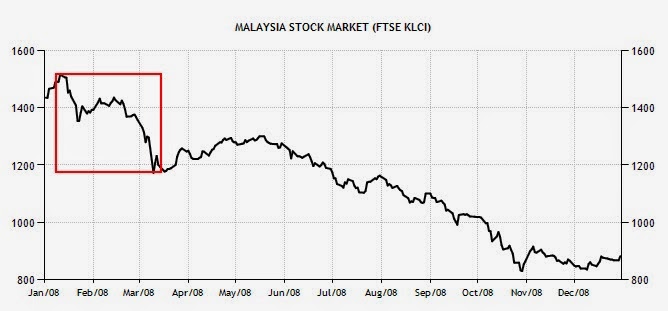What is a bear market?
According to definition in Investopedia, bear market is a condition in which the prices of securities are falling, and widespread pessimism causes the negative sentiment to be self-sustaining.
Although figures may vary, a downturn of 20% or more in multiple broad market indexes over at least a 2-month period is considered entry into a bear market.
A bear market should not be confused with a correction, which is a short-term trend that has a duration of less than 2 months.
So back to the earlier question, can we predict a bear market? Of course the broad answer will be NO.
Nevertheless, it's always beneficial to look back into the history and learn from it.
The chart below shows KLCI's level from 1990 to present (April 2014).
It is obvious that in this period of time, there are two big bear market as most of us already know. They are 1997-98 Asian Financial Crisis and 2008-09 Global Financial Crisis.
However, from early 2000 til mid 2001 (blue box), KLCI tumbled from 1,000 to below 600 points (fell 40%). By definition it should be another bear market, but it might be part of the 97-98 crisis as the overall market did not recover to pre-crisis level yet.
During the 1997-98 crisis, KLCI started to fall from around 1,250 points in early 1997. Its fall reached 20% 4-5 months later at 1,000 points in July. By definition, it is an entry into a bear market.
True enough, KLCI, together with world market, tumbled from a high of 1,250 to merely 300 points in one and a half year's time.
If investors withdrew themselves from the stock market at the point of entry of bear market in July 1997, then they actually made a correct decision.
After it found its bottom around Sept 1998, KLCI recovered rapidly in which the index doubled itself in 6 months time and continued to climb to 1,000 in early year 2000.
From early year 2000, KLCI entered another "small" bear market as mentioned earlier in this article.
Referring to chart above, around Feb 2000, KLCI stood at 1,000 points, it then fell 20% to 800 points in July 2000, which was more than 2 months later. Again, it was proven right as the market entered bear market and KLCI continued to fall another 30% in the next one year.
After this, KLCI staged a gradual comeback for the next 5 years. However, it did not reach its pre 97-98 crisis level of 1,200 points until a super bull run between 2006 & 2007 propelled KLCI to 1,400 level.
Anyway, from 2002 to 2003, KLCI fell a little over 20% (around 22%) from 800 points to 625 points in about 6 months time, as shown in chart below.
This is supposed to be another entry into bear market by definition, but this time it was not. KLCI managed to correct itself to continue with previous uptrend.
This just shows that market is unpredictable and there is no hard and fast rule here.
At the peak of the super bull run, the world was succumbed to another financial crisis which saw KLCI tumbled from 1,500 points to slightly above 800 points in 12 months time.
There was actually a warning sign for it. The KLCI retreated 20% from 1,500 to 1,200 points in a little more than 2 months as shown in chart below. Investors who fled at this point and stayed aside for the next 12 months would have made a wise decision.
However, there is a small upward correction in April & May 2008. Some might felt that it was a false bear signal and re-entered the market. It was all about decision making.
Most relatively new investors may still remember there was a panic moment in 2011. In July that year, KLCI started to fall rapidly from 1,600 level (see chart below).
To be defined as entry into bear market, it needs to fall at least 20%, or at least to the level of 1,280 points.
However, this time it fell for about 16%. True enough, it was just a "big" correction and there was no bear.
Just in August last year, there was another nervous moment when KLCI fell more than 100 points from 1,800 to 1,700 points in less than one month. This 100 points was a mere 6% but it was enough to cause havoc among many investors.
Again, market in unpredictable and there is no hard and fast rule. If there is, then there will be no financial crisis as everyone is well-prepared for it.
Anyway, I think the 20% rule does make some sense.
Looking back at the historical KLCI chart again (below). It is not a surprise that some investors start to worry about bear market now.
KLCI recovers rapidly from 2008 crisis, much faster than the 1997 crisis. It looks like it is at risk for a bear or at least big correction anytime soon.
But no one can predict the market accurately.
To fulfill the definition of entry into bear market, KLCI at 1,850 points now need to drop at least 370 points or at least to the level of 1,480 points.
The 1,480 points level is supposed to be only the early stage of a bear market...
Will you wait until 1,480 to act?











did u feel that bear market is coming near?
ReplyDeleteChris, I think this year should be fine
ReplyDelete